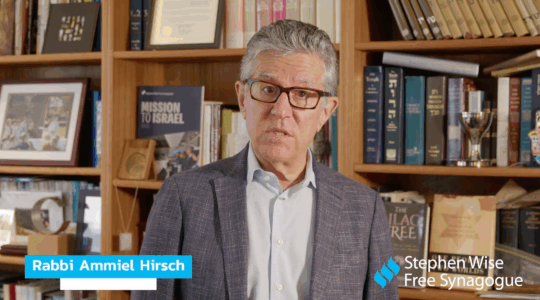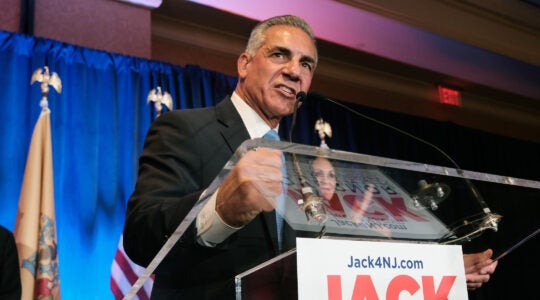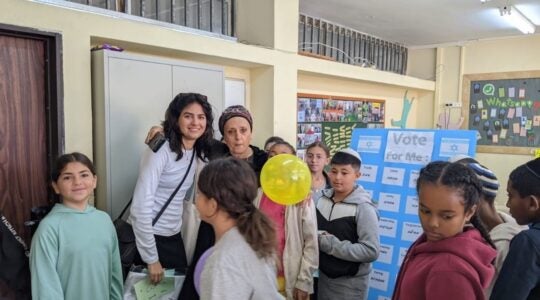NEW YORK (JTA) – There’s a secret handshake known by members of AZA, the teen fraternal order of B’nai B’rith Youth Organization. One AZA brother extends his right hand; the other takes it. Each wraps his pinky finger around the outside of the other’s hand and extends his index finger so it rests on the other’s wrist, on the pulse.The shape of the two hands together is supposed to look like the Hebrew letters aleph zadek aleph – AZA.Beyond that, though, “it’s about brotherhood and the heartbeat of AZA,” explains Ian Schwartz, a junior at Half Hollow Hills High School East in Dix Hills, N.Y., demonstrating the handshake on a BBYO-sponsored bus full of high school students heading to Boston in late March for a tour of colleges.The pulse of BBYO, the parent organization of AZA and its sister organization, B’nai B’rith Girls, had become faint until an infusion of care and cash from the Charles and Lynn Schusterman Family Foundation five years ago gave it new life.At a time when philanthropic funds are flowing into the Jewish community at a record clip, BBYO illustrates what the synergy between money and thoughtful leadership can achieve. “There’s a triad: You need money, you need good ideas, and you need good professional leadership,” said Gary Tobin, president of the Institute for Jewish & Community Research in San Francisco. “Without all three of those, you go nowhere. You can have all the ideas and great professionals you want, but if you don’t have the money, you can’t execute. If have great ideas and money and no leadership, you can’t execute.”Tobin said he knows BBYO has hired great staff, who have come up with innovative ideas. If the Schusterman money is allowing the money and ideas to work, he said, “you have a winner.”At BBYO’s height in the 1950s and ’60s, one in seven North American teens belonged to the organization through AZA and B’nai B’rith Girls, according to BBYO Executive Director Matt Grossman. Among them were many who went on to achieve prominence, including Dallas Mavericks owner Mark Cuban, Watergate reporter Carl Bernstein, NBC Executive Vice President Marc Graboff and U.S. Rep. Shelley Berkley (D-Nev.).But BBYO membership dwindled from about 50,000 at its height to about 13,000 in the 1990s. Teenagers had evolved; BBYO had not.”It was always old-school and hadn’t changed in about 40 years,” said Francis Haskell, regional director of BBYO’s Nassau-Suffolk Region in New York, which organized the college bus tour for 24 teens.BBYO in the past five years has rebounded under new leadership, the result of refocusing and launching scores of new initiatives to meet teens where they are now. The group’s membership has risen to 25,000; the organization has set its sights on returning to its peak size by the end of the decade. Haskell’s region, for instance, has grown since September from 350 members to 1,100, and has a goal of 1,401 members by June.The growth comes at the same time as the geographic spreading of the Jewish community has contributed to a steady decline in youth-group involvement since the 1960s and ’70s, according to sociologist Steven M. Cohen.Behind the turnaround is the involvement of one former member, Charles Schusterman. As a teenager, the future philanthropist was the “gadol” — BBYO-speak for president — of his chapter in Tulsa, Okla.Before his death in 2000, Charles Schusterman had been on a search committee to find a new BBYO national director. After he died, his wife, Lynn, became chair of the family foundation and picked up the torch.In an interview at the Jewish Funders Network Conference in Atlanta in March, Lynn Schusterman told JTA that she was interested in the organization because of its transdenominational nature. She saw it as a vehicle that could attract unaffiliated Jews, as does Hillel: The Foundation for Jewish Campus Life, another organization with which her foundation is heavily involved.Schusterman saw how the American Israel Public Affairs Committee had succeeded in galvanizing Jewish college students around the Israel debate, and felt that BBYO had the potential to excite them as well. But BBYO was tethered to a parent organization, B’nai B’rith International, that was floundering as well — a fact that even B’nai B’rith International officials acknowledge. With her initial $1 million grant to the organization in 2002 — which since has grown to about $2.5 million per year — Schusterman pushed for BBYO to secede from the parent organization. BBYO cut its ties with B’nai B’rith International on April 1, 2002, becoming the latest in a string of organizations fostered by B’nai B’rith to leave the parent.B’nai B’rith International remains a major BBYO funder, recently committing to give the youth group $2.5 million over the next five years, and still has five members on BBYO’s board of trustees, according to Mark Olshan, B’nai B’rith International’s associate executive vice president. The separation was aimed at bringing in new fund-raising sources, Schusterman said, and it seems to be succeeding: Total contributions to BBYO have risen from $1.85 million in 2002 to an expected $5.25 million by the end of this school term. The organization’s overall budget has risen from $4 million to $10 million. Before it became independent, BBYO never maintained formal tabs on its alumni or reached out to them. But over the past several years it has compiled a list of more than 200,000 alumni, which should grow as the organization sorts through 75 boxes with lists of alumni sent last summer from BBYO offices across the country.The professional staff also needed an overhaul. It was in disarray in 2001, with only three professionals in its national office in Washington and only 65 in all, Grossman said. It now has 25 professionals in its national headquarters, which remain in the B’nai B’rith International offices — and some 120 professionals in all. Much of the past two-and-a-half years has been devoted to finding exceptional personnel, from the professionals in the national office to the volunteers who help run individual chapters, Grossman and Schusterman said. In 2004, Grossman became the prize of the new hires. A rising star in Hillel as the top assistant to then-President Richard Joel, Grossman, now 36, became the youngest executive director of a major American Jewish non-profit group when he moved to BBYO three years ago.Grossman installed a strategic plan that essentially merged traditional BBYO philosophy — a youth-led platform, heavy on social action, that stresses the ideals of brotherhood and sisterhood — with new methods of connecting to teenagers today. It had to be relevant to a teen population that was interested not so much in dances and Shabbat dinners but in culturally engaging, meaningful Jewish opportunities.It also meant going where teens hang out, which these days means the Internet. One early initiative was b-linked.org. An online community where BBYO members create interactive profiles and form friend groups and interest-based discussions, b-linked has more than 12,000 registered teen users, according to Grossman. Teens not only can communicate about which BBYO events they plan to attend and discuss them afterward, on b-linked they are able to track community service hours they have logged, which in many schools are required. B-linked is an essential marketing tool, according to Sarah Shapiro, BBYO’s online initiatives associate. But it’s the technology behind b-linked that is especially important. BBYO staff has an online database, known as “the dashboard,” that tracks its teen members and 600 chapters, from events attended to membership payments. That allows the organization to see which events teens find interesting and which ones they don’t, and to find out what programming works best.The recent bus tour of Boston colleges was exactly the type of new programing that works, Grossman said, since a primary teen concern is where to attend college.Take Arielle Sidrane, for example. A senior at Commack High School, Sidrane, 18, is BBYO’s Nassau-Suffolk regional president and an exceptional student, but she hasn’t decided where to attend college next year — because she doesn’t really want to go immediately after high school. Sidrane became involved in the Save Darfur movement through BBYO. She helped send a group of 400 BBYO participants to the Save Darfur rally in New York last September, and she tries to attach a Darfur fund-raising component every time BBYO raises money.Sidrane wanted to defer college to work on the Darfur movement full-time, but her parents nixed the idea.So while most of the 24 students on the Boston bus trip were sophomores and juniors still considering where to apply to schools, Sidrane was visiting some schools to which she had grudgingly applied, such as Boston University and Tufts.The visits left her more open-minded and even excited about college because she saw that she could stay involved in the Darfur campaign while on campus. Sidrane also said she believes that college is a way to grow Jewishly, and plans to minor or major in Jewish studies.”This is all something I would have never considered until I was so involved in BBYO,” she said.
JTA has documented Jewish history in real-time for over a century. Keep our journalism strong by joining us in supporting independent, award-winning reporting.





